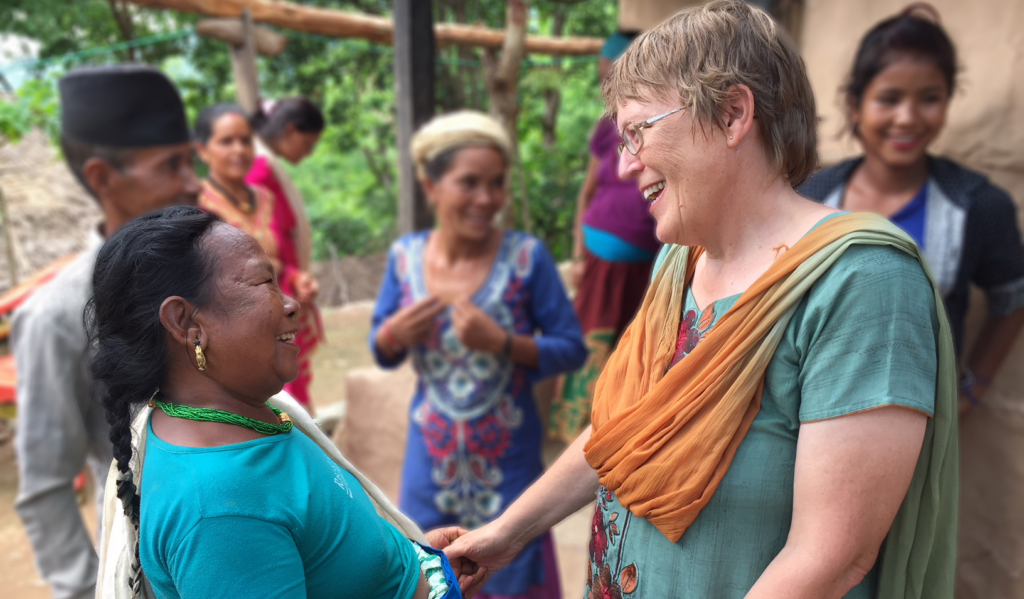Why Giving Feels Good: The Science of Generosity
By Sarah Welch, Associate Managing Director at ideas42
Rationales for Giving » Why Giving Feels Good: The Science of Generosity – by Sarah Welch

My favorite adaptation of Dickens’s holiday classic is The Muppet Christmas Carol. Michael Caine’s transformation from Scrooge the miser to Scrooge the philanthropist—and the joy of the Ghost of Christmas Present—brings me to happy tears every year I watch it with my kids. The lesson is familiar: It’s better to give than to receive.
But after the movie’s over, it’s worth asking whether we truly believe that. Only about half of American households donate each year; on average, they give less than 2 percent of their after-tax income.[1] Is the giving spirit just holiday fantasy?
Not at all—research shows that helping others really does seem to be good for us. In one study,[2] participants were given $5 or $20 and either told to spend it on themselves or someone else. Those who spent the money on others reported greater happiness than those who spent the money on themselves. Nevertheless, we often underestimate the joy we will get from helping other people: In that same study, participants incorrectly predicted that spending on themselves would make them happier.

We humans are not always good at predicting what makes us happy, especially with regard to to prosocial activities[3] (for example, chatting with strangers brings more joy than anyone ever expects[4]). When it comes to giving, it’s not just small boosts to happiness that we risk missing out on; research suggests that generosity may also improve mental and physical health and strengthen social bonds.
Charitable donations can have a meaningful impact, alleviating hunger and other life-threatening challenges of extreme poverty. But giving isn’t solely about helping others; it also brings significant rewards for the giver. Embracing this can unlock more generosity in ourselves and our communities.
From a very young age, humans show a natural tendency toward generosity. Take, for example, one study[5] in which toddlers were observed offering treats to puppets. The children reacted with the greatest happiness when sharing their own treats with the puppets, more than getting treats themselves, or serving the puppets treats provided by the researchers.
But for a long time, economists struggled with models of charitable giving in adults. While altruism made sense—contributions to the “greater good” ultimately benefit us all—research showed that people continued to give even when other support, like government funding, could meet the need. Finally, in 1990, American economist James Andreoni introduced a new model that incorporated “warm glow,” positing that the act of giving brings emotional satisfaction, or utility, on its own.[6] Just like children sharing with puppets, adults get happiness simply from the act of being generous.
The warm glow model has an important implication: The satisfaction we get from giving is mostly independent of any measurable impact of our donation. In one study,[7] volunteers were offered the opportunity to privately contribute some part of their participation payment to charity. It was made clear, however, that no matter how much or little they gave, the experimenters would make up the rest to ensure each charity got exactly $10. Any individual’s donation would have no impact on the charity. More than half of participants still chose to donate, suggesting that they gave only for the feeling of warm glow it inspired—and that warm glow is a strong driver for many individual acts of generosity.
Researchers have found positive correlations between charitable giving and happiness around the world, including both richer and poorer countries, and controlling for factors like income and other demographic characteristics. Of the 136 countries examined, 120 showed evidence that spending on others increased happiness. [8]
The benefits of donating to charitable causes appear to extend beyond just fulfillment of moral or religious duty or short-term emotional gratification. Several studies suggest that generosity is also good for our health—both mental and physical.[9] For older adults, giving support to others correlated with better health outcomes and increased life expectancy, controlling for community and demographic factors.[10] Research from neurobiology suggests that engaging in giving and other helping behaviors releases hormones that measurably reduce stress and provide restorative benefits.[11]
Giving can also be a tool for social connection. Much has been made recently about our epidemic of loneliness and our fraying social fabric.[12],[13] Giving and volunteering may help us connect with others and strengthen relationships.[14],[15] Giving circles, where individuals pool their resources to collectively decide on charitable donations, amplify this effect. Members of giving circles report feeling more connected to their community and are more engaged in philanthropic activities.[16],[17]
A Behavioral Call for Giving
The research is clear: Helping others makes us happier. Charitable giving is more than a transfer of resources to correct injustice; it is a mutually enriching act that enhances our personal well-being, strengthens social fabric, and fosters community. Through giving, donors can make a meaningful difference while experiencing the profound rewards that generosity brings.
As a bonus, it might even lead you to sing with Muppets while dancing down the street.[18]
[1] Giving USA: The Annual Report on Philanthropy for the Year 2023 (2024). Chicago: Giving USA Foundation.
[2] Dunn, E. W., Aknin, L. B., & Norton, M. I. (2014). Prosocial spending and happiness: Using money to benefit others pays off. Current directions in psychological science, 23(1), 41-47.
[3] Epley, N., Kumar, A., Dungan, J., & Echelbarger, M. (2022, August 12). A Prosociality Paradox: How Miscalibrated Social Cognition Creates a Misplaced Barrier to Prosocial Action. https://doi.org/10.31234/osf.io/9t3wf
[4] Epley, N., & Schroeder, J. (2014). Mistakenly seeking solitude. Journal of Experimental Psychology: General, 143(5), 1980–1999. https://doi.org/10.1037/a0037323
[5] Aknin LB, Hamlin JK, Dunn EW (2012) Giving Leads to Happiness in Young Children. PLOS ONE 7(6): e39211. https://doi.org/10.1371/journal.pone.0039211
[6] Andreoni, J. (1990). Impure Altruism and Donations to Public Goods: A Theory of Warm-Glow Giving. The Economic Journal.
[7] Crumpler, H., & Grossman, P. J. (2008). An experimental test of warm glow giving. Journal of Public Economics, 92(5-6), 1011–1021. https://doi.org/10.1016/j.jpubeco.2007.12.014
[8] Aknin, L. B., Barrington-Leigh, C. P., Dunn, E. W., Helliwell, J. F., Burns, J., Biswas-Diener, R., … & Norton, M. I. (2013). Prosocial spending and well-being: cross-cultural evidence for a psychological universal. Journal of personality and social psychology, 104(4), 635.
[9] Konrath, S. & Brown, S. (2012) The effects of giving on givers. Handbook of Health and Social Relationships, Nicole Roberts & Matt Newman (Eds.) APA Books, Washington, 39-64
[10] Brown, W. M., Consedine, N. S., & Magai, C. (2005). Altruism relates to health in an ethnically diverse sample of older adults. The Journals of Gerontology Series B: Psychological Sciences and Social Sciences, 60(3), P143-P152.
[11] Brown, S. L., & Brown, R. M. (2015). Connecting prosocial behavior to improved physical health: Contributions from the neurobiology of parenting. Neuroscience & Biobehavioral Reviews, 55, 1-17.
[12] https://www.hhs.gov/about/news/2023/05/03/new-surgeon-general-advisory-raises-alarm-about-devastating-impact-epidemic-loneliness-isolation-united-states.html
[13] https://www.nytimes.com/2024/07/13/magazine/robert-putnam-interview.html
[14] https://dogood.umd.edu/sites/default/files/2024-01/FINAL_SocialConnectednessandGenerosity_2024.pdf
[15] https://www.vox.com/culture/368201/volunteer-charity-donations-systemic-change-activism-nonprofits-loneliness-philanthropy
[16] Eikenberry, A. M. (2006). Giving Circles: Growing Grassroots Philanthropy. Nonprofit and Voluntary Sector Quarterly.
[17] https://johnsoncenter.org/wp-content/uploads/2024/04/in-abundance-an-analysis-of-the-thriving-landscape-of-collective-giving-in-the-u-s.pdf
[18] https://www.youtube.com/watch?v=WlRpGj7LWS4&ab_channel=coulterscandy
SHARE THIS ARTICLE
Get the next Rationales For Giving article straight in your inbox – subscribe below 👇
